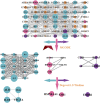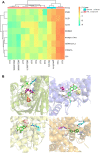Clinical efficacy evaluation and potential mechanism prediction on Pudilan Xiaoyan oral liquid in treatment of mumps in children based on meta-analysis, network pharmacology, and molecular docking
- PMID: 36210814
- PMCID: PMC9537475
- DOI: 10.3389/fphar.2022.956219
Clinical efficacy evaluation and potential mechanism prediction on Pudilan Xiaoyan oral liquid in treatment of mumps in children based on meta-analysis, network pharmacology, and molecular docking
Abstract
Background: Mumps is caused by the mumps virus and is characterized by pain and parotid gland swelling. Although its incidence has declined due to vaccines, outbreaks still occur among children. In addition, it can lead to severe complications, so it has a certain perniciousness. Pudilan Xiaoyan oral liquid (PDL), a Chinese patent medicine, commonly treats children with mumps. However, its safety, efficacy, and specific mechanisms lack relevant evaluation and analysis. Therefore, we did a meta-analysis of the randomized controlled trials combined with a network pharmacology analysis to assess the efficacy and safety of PDL in relieving symptoms of mumps in children and investigate its pharmacological mechanisms. Methods: This study systematically searched the China National Knowledge Infrastructure (CNKI), WanFang Data Knowledge Service Platform, VIP Database, Sinomed, Chinese Medical Journal Full-text Database, PubMed, Embase, Cochrane Library, Web of Science, and Google Scholar for the published randomized controlled trials (date up to 3 March 2022; studies in both English and Chinese) comparing PDL and antiviral drug combination treatment to standalone antiviral drug treatment. The primary outcomes in this study were the effective rate and duration of five characteristic symptoms of children's mumps. We assessed the pooled data by using a fix-effect or random-effect model. We illustrated an odds ratio (OR) or standardized mean difference (SMD) with a 95% confidence interval (CI) using the Stata 15 software. In network pharmacology, active components of PDL were collected from the traditional Chinese medicine system pharmacology technology platform and the CNKI studies, while mumps' targets were collected from databases of the Genecards and Online Mendelian Inheritance in Man (OMIM), and then we constructed a "drug-component-target" network and a protein-protein interaction network using Cytoscape 3.9.0 for screening the core components and targets. Next, we ran Gene Ontology (GO) and Kyoto Encyclopedia of Genes and Genomes (KEGG) analysis of intersection targets of PDL and mumps. Finally, molecular docking was performed between core components and targets. Results: Of 70 identified studies, 12 were eligible and included in our analysis (N = 1,307 participants). Compared with the antiviral drug treatments, combination treatment using PDL and antiviral drugs provided higher effective rates (OR = 5.94), shorter symptom durations for fever (SMD = -1.05), headache (SMD = -0.69), parotid gland swelling (SMD = -1.30), parotid gland pain (SMD = -2.53), and loss of appetite (SMD = -0.56) with fewer reported side effects. Of the 113 active components of PDL and 57 mumps' targets, 11 core components like quercetin, isoetin, and seven core targets such as albumin (ALB) and interleukin-6 were obtained. Moreover, the potential pathways identified included cytokine-cytokine receptor interaction and T helper cell 17 (Th17 cell) differentiation. Molecular docking results revealed that most core components and targets could form stable structures. The core components, including isoetin, quercetin, and luteolin, and core targets involving heat shock protein HSP 90-alpha (HSP90AA1), estrogen receptor (ESR1), and ALB showed the best affinities. Conclusion: The combined use of PDL and antiviral drugs could effectively improve the efficacy of mumps among children and rapidly alleviate mumps-related symptoms. This efficacy may be associated with the anti-inflammatory and antiviral mechanisms by which PDL acts using multiple components, multiple targets, and multiple pathways. However, these results should be confirmed by further studies.
Keywords: Pudilan Xiaoyan oral liquid; meta-analysis; molecular docking; mumps; network pharmacology; randomized controlled trials; traditional Chinese medicine.
Copyright © 2022 Liu, Cui, Xi and Xie.
Figures
















Similar articles
-
Efficacy and Mechanism of Core Traditional Chinese Medicines for Treating Malignant Lymphoma based on Efficacy Studies: A Study Supported by Network Pharmacology and Molecular Docking.Curr Pharm Des. 2024;30(33):2652-2666. doi: 10.2174/0113816128308565240710114350. Curr Pharm Des. 2024. PMID: 39082169
-
Efficacy of Danlou tablet on myocardial ischemia/ reperfusion injury assessed by network pharmacology and experimental verification.J Tradit Chin Med. 2024 Feb;44(1):131-144. doi: 10.19852/j.cnki.jtcm.20231121.003. J Tradit Chin Med. 2024. PMID: 38213248 Free PMC article.
-
Research on the Regulatory Mechanism of Ginseng on the Tumor Microenvironment of Colorectal Cancer based on Network Pharmacology and Bioinformatics Validation.Curr Comput Aided Drug Des. 2024;20(5):486-500. doi: 10.2174/1573409919666230607103721. Curr Comput Aided Drug Des. 2024. PMID: 37287284
-
Systematic review of Buzhong Yiqi method in alleviating cancer-related fatigue: a meta-analysis and exploratory network pharmacology approach.Front Pharmacol. 2024 Nov 5;15:1451773. doi: 10.3389/fphar.2024.1451773. eCollection 2024. Front Pharmacol. 2024. PMID: 39564104 Free PMC article.
-
Systematic review of Kaixinsan in treating depression: Efficacy and pharmacological mechanisms.Front Behav Neurosci. 2022 Dec 6;16:1061877. doi: 10.3389/fnbeh.2022.1061877. eCollection 2022. Front Behav Neurosci. 2022. PMID: 36560929 Free PMC article.
Cited by
-
Exploring the potential mechanisms of Tongmai Jiangtang capsules in treating diabetic nephropathy through multi-dimensional data.Front Endocrinol (Lausanne). 2023 Nov 1;14:1172226. doi: 10.3389/fendo.2023.1172226. eCollection 2023. Front Endocrinol (Lausanne). 2023. PMID: 38027201 Free PMC article.
-
Efficacy and potential pharmacological mechanism of Astragalus-Salvia miltiorrhiza combination in diabetic nephropathy: integrating meta-analysis, network pharmacology, molecular docking, and experimental validation.Ren Fail. 2025 Dec;47(1):2466116. doi: 10.1080/0886022X.2025.2466116. Epub 2025 Feb 27. Ren Fail. 2025. PMID: 40015687 Free PMC article.
References
Publication types
LinkOut - more resources
Full Text Sources
Miscellaneous

